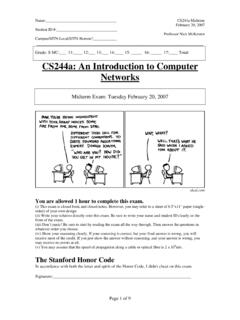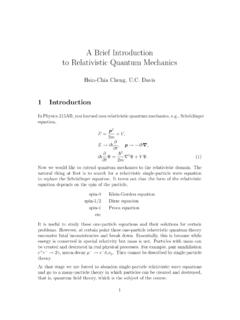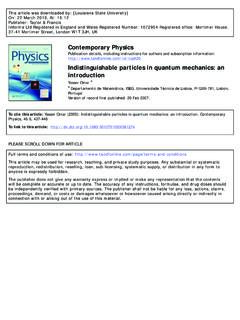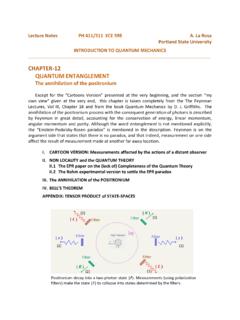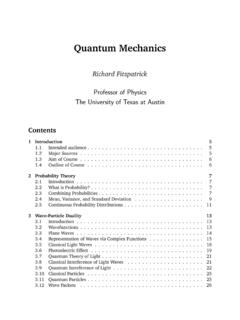Transcription of Introduction to Quantum Mechanics - Stanford …
1 Introduction to Quantum MechanicsGary OasEducation Program for Gifted Youth, Stanford UniversityMarch 23, 2008 IntroductionThis two week course on Quantum Mechanics is meant to give a quantitative Introduction to the theory and explore itsimplications for technology and philosophy. Though the complete theory will be introduced, this course is not intendedto bea formal Introduction . That is, the goal is not meant to have the student be able to calculate with the theory, but to conveyits essence and meaning. Concentration will be on the foundational issues that have significant impact on the philosophicalmeaning of reality, existence, and interaction. Time permitting a short foray into the technologies of the future basedonquantum entanglement will be course has been taught successfully for the past six years including two previous classes held in Singapore. In total156 students have passed through this course, 24 of those in the Singapore , Assignments, StructureThere is no textbook for the Quantum Mechanics course.
2 The course is based on lecture notes that will be provided. Thereare two inexpensive books that are useful and are drawn aboutoccasionally. They are, The Quantum Challenge: Modern Research on the Foundations of Quantum Mechanicsby G. Greenstein, A. is an excellent text that explores experimental verification of the foundational issues of Quantum assignments may be given, copies will be provided. At times the level of this book goes beyond the level ofthis course, as it is intended for physicists, but much is appropriate for the material covered. The Strange World of Quantum Mechanicsby Daniel is a very approachable Introduction to the mysterious properties of Quantum Mechanics . This course was originallybased on this book but it does not go into certain topics with enough rigor - a recommended read. Relevant research papers will be available on the course day there will be an assignment to be completed by the endof the day. There may be one or two problems thatspan a few days.
3 Assignments will be examined and random subsets of the problems will be course web site will be provided just prior to commencement of the class. This site should be consulted prior tobeginning the class as well as during the course. Updated course notes, problem solutions, and relevant papers, links will PhysicsOriginsConceptsTheoryQM weirdnessExperimentsApplicationsMeaningM ath:Differential # , DemonstrationsThere will be several physical demonstrations during the course often centering on optics. There are no laboratories inthiscourse but there is one assignment where students study circularly polarized light by creating an analyzer. Depending uponavailability of resources, an interferometer will be demonstrated and students will be asked to verify the conclusionsof thequantum eraser outlineThe following is an optimal plan of lectures. There are oftenslight changes during the course depending on student responseand 1: What s Wrong With Classical Physics? Light 1A brief qualitative review of classical Mechanics (Newton s laws, Maxwell s equations, thermodynamics) will precedea laundrylist of physical phenomena which are not explained by classical physics.
4 The later part of the lecture will focus on the debateof the nature of light throughout history up to Einstein s explanation of the photoelectric 2: Photoelectric Effect. Wave/Particle DualityA closer examination of the photoelectric effect and its implications on the nature of light is discussed. This leads us tothewave/particle duality concept of photons. The double slit experiment will be explored in the wave interpretation of light andalso in the particle interpretation. The later will necessitate a new form of physical 3: The WavefunctionIn order to have a consistent description of light a new quantity, the wavefunction, is introduced. The properties of thewavefunction and its meaning will be explored. de Broglie sthesis of 1924 posits that this new Mechanics does not just applyto light but to all subatomic entities. At this point the mathematical nature of the light Quantum (photon) is 4: The Wave EquationThe extension of the Quantum theory of the photon to particles with mass (electron) introduces a new wave equation,Schrodinger s Equation that needs to be explored.
5 A brief foray into the mathematical solutions to simple solutions of thisequation will elucidate the main counter-intuitive effectsof Quantum Mechanics .[Key ideas: Measurement problem, complementarity]Lecture 5: Quantum Mechanics in One DimensionContinuing with some simple one dimensional problems involving the Schrodinger equation the mysterious underpinnings ofthis new theory will begin to first week will conclude by examining some modern experiments of Quantum optics and their bearing on the founda-tional structure of Quantum Mechanics .[Key ideas: Quantum tunneling, complementarity, contextuality]Lecture 5 afternoon: Background IssuesSome additional properties of light (polarization, etc.) and electrons (spin) will be introduced. An outline of the full theoryof Quantum Mechanics will be given. Time permitting, mathematical basis will be explored 6: Two state systemsExploring systems that have only two possible measurement outcomes (polarization of light, electron spin) the mathematicssimplifies (no partial differential equations).
6 A different formalization of such systems (Dirac bra-ket vectors) allows fordiscussion of many of the recent discoveries of Quantum Mechanics . This lecture will introduce this abstract method inrelation to photon polarization and electron spin. Experimental methods of measuring these states will be discussed.[Key ideas: Hilbert space]2 Lecture 7: Quantum Optics Experiments: EntanglementWith a firm basis in the Quantum Mechanics of two state systemsunderstood, several recent experiments can be experiments demonstrate the mysterious nature of Quantum Mechanics and mainly hinge on the property ofentangle-ment- that two distant particles can somehow share instantaneous 8: Foundational Issues: of Quantum Mechanics : Bell s InequalitiesIn this lecture tests of theories claiming to be local are introduced. The most well known are calledBell Inequalities-expressions for the expectations of outcomes of a system that must be satisfied by any theory that has local causation. It isobserved that Quantum mechanical systems (primarily within the area of Quantum optics) violate these inequalities by manystandard deviations.
7 [Key ideas: Expectation values, Bell Inequalities, GHZ]Lecture 9: Quantum InformationFor much of its history, the Quantum mechanical mysteries seemed to be problems that needed to be resolved. Withexperimental verification of the bizarre nature of the theory, methods to exploit these strange effects began in the the basic ideas behind Quantum ; cryptography, teleportation, computing, etc. will be 10: Quantum Computing, Advanced Topics, Loose EndsThis lecture will either continue to discuss the basics of Quantum computing or be an overview of more advanced topics: Quantum field theory, the standard model, Quantum gravity, and string lecturesOften students want to hear more about certain aspects of physics. Since this course is distilled from a longer course, manyadditional lectures can be included. This is usually determined by available time and student vote. These topics include, Pauli Exclusion Principle, the Periodic Table, and Neutronstars. Semiconductors (diode lasers).
8 Nanotechnology Quantum Field Theory. Quantum gravity, string the level of this course can be adjusted somewhat to the nature of the class it is difficult to avoid some formalmathematics to truly understand the subject. Thus, students should have been exposed to physics in a prior course. Studentsshould feel comfortable with Mechanics and electricity & magnetism. In terms of mathematics, students should have takenan initial course in calculus. Mainly, students should feelcomfortable with taking derivatives of functions. Integrals areavoided as much as possible but may appear here or these prerequisites will help students understand the curriculum, they are not the limit that students will beexposed. In the course, students will be introduced to some higher mathematics (partial derivatives, differential equations,vector spaces) and physics (wave phenomena, optics). In thepast, students not quite meeting all of the prerequisites havebeen admitted and often do very well. However, a little more work is required to fill in the gaps.
9 Enthusiasm for the topic ispivotal to success in this Details Lecture hours: 10 lectures, hours per lecture = 25 lecture hours. Problem solving session (with TAs and instructor) 10 X 2 = 20 hours. Total instructor-student interaction time: 45-50 hours. (Including non-instructional time 60 hours).3 In total there are about 35 problems assigned. They vary in difficulty; some being straight forward mathematicalproblems, to the last assignment which requires two days andinvolves verifying the calculations of an important recentpaper on the foundations of Quantum Mechanics .(The substitution of additional lectures may decrease the problem solving time and increase the lecture time by a few hours.)4 Instructor: Gary OasGary Oas received a in physics from the University of Michigan in 1987 and a Phd. in physics from the University ofCalifornia, Davis in 1995. Gary joined EPGY in 1995 as the head of physics instruction and has been there ever since. Overthe years he has developed most of the computer-based distance learning physics course, often in conjunction with Stanfordfaculty.
10 The last course, P130 Introduction to Quantum Mechanics , was produced in close coordination with Prof. LeonardSusskind -one of foremost significant figures in theoreticalphysics. Beginning in 2001, and at Dr. Oas urging, summer campsin math and physics on the Stanford campus were instituted. The relativity course was one of the two courses offered thatinaugural year. Since then the Summer Institute program hasgrown to include a diverse range of topics from music theoryto business. The initial class of 40 has now blossomed into a 1000 per summer program and continues to grow. The relativitycourse is still one of the more popular courses offered and hasnow had over 200 students pass through it. The second year ofthe program added the Quantum Mechanics course, and in lateryears the cosmology and particle physics courses. Dr. Oasstill teaches the relativity and Quantum Mechanics coursesat Stanford each summer. In 2004, with EPGY beginning to offercourses overseas, Dr. Oas began to teach in Singapore, varying between the relativity and Quantum Mechanics not teaching and developing the EPGY courses, Dr.

